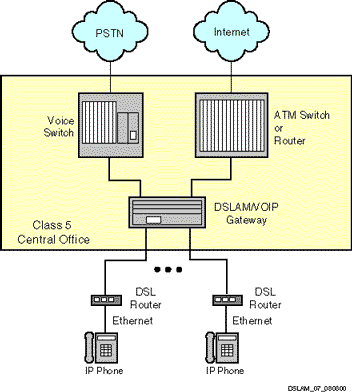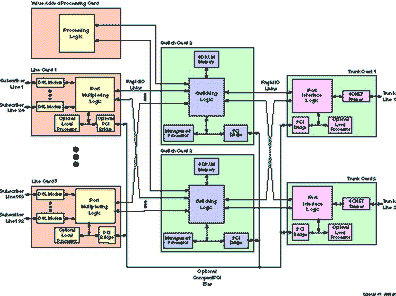|
Overview
Digital Subscriber Line Access Multiplexers (DSLAMs) are a key element in the infrastructure used to deliver broadband Internet access. The function of DSLAMs is to aggregate digital data traffic from Digital Subscriber Lines (DSL) before it is transferred to an ATM switch or Internet Protocol (IP) router. Figure 1 illustrates where a DSLAM fits into the architecture of a DSL services delivery system.
FIGURE 1 DSL Services Delivery Architecture

DSLAMs are connected to the rest of the architecture through two types of interfaces. On subscriber side are the DSL interfaces that connect to subscribers through standard twisted pair wiring. A typical DSLAM supports a couple of hundred DSL lines per shelf (a single rack mount chassis). On the network side are one or more trunk lines that carry the multiplexed traffic from the DSLAM to a switch or router, which is in turn connected to the Internet. The trunk interfaces are high bandwidth (155 or 622 Mb) SONET fiber optic links.
The ADSL Forum defined the following encapsulation schemes for data transport across DSL links.
The first two of these are frame-based transports (i.e. data is carried in variable length packets) while the third uses fixed length ATM cells. All of these schemes assume that ATM will be used for transport across the trunk link, and that segmentation and re-assembly (SAR) will be performed on frame based subscriber traffic by the DSLAM.
Just to make things more flexible (and complicated), leading vendors of DSLAMs also support transports beyond the DSL Forum defined schemes. These schemes include operating the DSLAM as an IP multiplexer feeding traffic directly to core routers. Clearly a flexible DSLAM implementation approach is needed to keep pace with this evolving suite of technologies.
There are several trends in network deployment that will effect the implementation of DSLAMs:
| Cost: |
Service providers are under intense pressure to reduce the cost of DSL access. Reduced costs will increase the penetration of DSL services and bring economies of scale. Cost components of DSL services include cost of Customer Premises Equipment (CPE), cost of access equipment including DSLAMs and the administrative costs of provisioning subscribers. |
| |
| Convergence: |
The hottest topic in networking is the convergence of voice and data services over a single network. The benefit to the end user will be lower voice services costs and additional features. Convergence will also benefit Competitive Local Exchange Carriers (CLECs) since it will let them provide voice services over DSL (VODSL) to augment revenue. |
Currently VODSL services are implemented through the use of a separate Voice Over IP (VOIP) gateway. While this approach is simple to implement, it requires that a new piece of equipment must be introduced into the network, which adds cost both in terms of the equipment itself, and support overhead.
Another approach is to add VOIP gateway functionality to the DSLAM itself. Figure 2 illustrates how this affects the overall architecture of a DSL services delivery system.
FIGURE 2 VODSL Using DSLAM with Integrated VOIP Gateway

Xilinx DSLAM Reference Architecture
The Xilinx DSLAM Reference Architecture was developed to show how Xilinx programmable technology when coupled with IP from Xilinx and AllianceCORE partners provides a flexible DSLAM solution that can be field upgraded. Key objectives for the architecture include:
- Scalability in terms of port counts and port data rates.
- Support for both frame and cell transport.
- Ability to integrate value added functions such as VOIP gateways.
- Fault tolerance by minimizing single points of failure.
- Field reconfigurability.
- Low Cost.
Figure 3 illustrates the architecture and shows its key components. The design consists of three types of cards:
- Line Cards containing the DSL modems and port multiplexing logic.
- Switch Cards that multiplex traffic from the line cards onto the trunk link(s). These cards also perform traffic management functions.
- Trunk Cards that contain the optical trunk interface.
- Value Added Processing Cards that implement specialized processing functions beyond the scope of what is normally implemented in a DSLAM.
The cards are connected by RapidIO high speed, point to point links. These links are not only used for transferring data but also for in-band management functions. Separate links between the Line Card and two Switching Cards provides redundancy and fault recovery capabilities. Key requirements for these links are high speed, reliable data transport over a limited number of pins.
An optional CompactPCI backplane can be used for system management. The disadvantage of using the CompactPCI backplane is that as a shared resource it represents a potential single point of failure, and does not provide the same scalable bandwidth that is provided by RapidIO.
FIGURE 3 DSLAM Block Diagram

Why RapidIO?
For this application, the new RapidIO standard is a good fit. RapidIO is a high performance, low pin count, packet switched system level interconnect architecture. The interconnect architecture is intended to be an open standard which addresses the needs of a variety of applications from embedded infrastructure to desktop computing. Applications include interconnecting microprocessors, memory, and memory mapped I/O devices in networking equipment, storage subsystems, and general purpose computing platforms. This interconnect is intended primarily as an intra-system interface, allowing chip to chip and board to board communications at giga-byte per second performance levels. Supported programming models include globally shared distributed memory and message passing. For more information about
RapidIO including a technology background white paper please refer to the RapidIO Web site.
|


